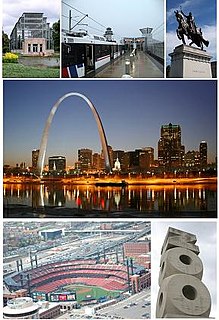
Orangeville is a village in Stephenson County, Illinois. The population was 793 at the 2010 census, up from 751 in 2000. The area's earliest white settlers arrived in the year 1833, and the village was platted in 1851 by John Bower, who is considered the village founder. In 1867 Orangeville was incorporated as a village. The town's central business district contains several 19th century commercial buildings, many of which were built during the railroad boom of 1888–1914. By the time the Great Depression was ongoing, business in Orangeville had started to decline, with the last bank closing in 1932. Although recently infrastructure jumps have given back some of its old decor.
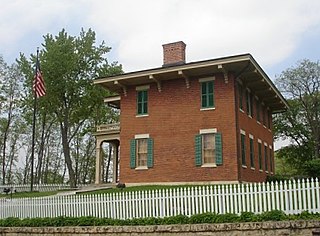
The Ulysses S. Grant Home in Galena, Illinois is the former home of Ulysses S. Grant, the Civil War general and later 18th President of the United States. The home was designed by William Dennison and constructed in 1859 - 1860. The home was given to Grant by residents of Galena in 1865 as thanks for his war service, and has been maintained as a memorial to Grant since 1904.

Pendarvis is a historic site located in Mineral Point, Iowa County, Wisconsin, United States. The site, which is listed on the National Register of Historic Places, is made up of several 19th century cabins built by Cornish immigrants who came to Mineral Point to mine lead. Today the site is owned by the Wisconsin Historical Society and serves as a museum of Wisconsin's early lead mining history. Programs at the site also interpret the groundbreaking preservation work by Robert Neal and Edgar Hellum, begun during the Great Depression.

The Old Market House, currently being operated as the Galena Welcome Center, is a brick building built in the Greek Revival style in 1845 in Galena, Illinois. It is owned and operated by the Illinois Historic Preservation Agency as an Illinois State Historic Site.
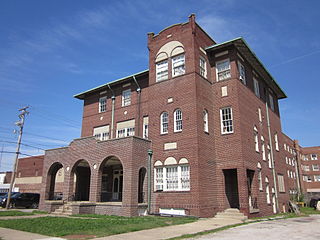
The Paris Elks Lodge No. 812 Building is a historic building located at 111 E. Washington St. in Paris, Illinois. The building served as a meeting place for the Paris lodge of the Benevolent and Protective Order of Elks. The building was constructed in 1927, 25 years after the Paris Lodge was chartered. Architect Everett Blackman, a member of the lodge, designed the building in the Mediterranean Revival style. Blackman's design features an arcade loggia enclosing the front entrance and a square tower with a parapet roof designed to resemble elk antlers. The building's amenities included a bar and ballroom on the second floor, a bowling alley in the basement, and meeting rooms for the lodge. The third floor of the building housed rooms for the adjacent France Hotel; it was connected to the hotel by a stone walkway and cannot be accessed from the lower floors. The Elks used the building until the lodge filed for bankruptcy in 1978.

The Nachusa House is a former hotel building in Dixon, Illinois, United States along Galena Avenue. The building was constructed in 1853 and operated continuously as a hotel until 1988. It underwent many alterations during the time it operated as a hotel. Following its period as a hotel the five-story mansard roofed building fell into disrepair and was nearly demolished in 1997. The building was restored by the Illinois Housing Development Authority and a Chicago developer at a cost of US$3.2 million and renovated into affordable housing for senior citizens. During its height the Nachusa House was a popular stop along rail and stagecoach lines and was a known layover for Abraham Lincoln. The Nachusa House was added to the U.S. National Register of Historic Places in 1983.

The Batavia Depot Museum is a museum in Batavia, Illinois that was once the town's primary train station. It was the first of many depots built by the Chicago, Burlington and Quincy Railroad. It was listed on the National Register of Historic Places in 1979 as the Chicago, Burlington, and Quincy Railroad Depot.

Stagecoach Trail is a historic route through northern Jo Daviess County and western Stephenson County, in the northwest of Illinois. The trail was a part of the larger Galena–Chicago trail that crossed almost the entire state.

The Elihu Benjamin Washburne House, also known as the Washburne-Sheehan House, is a 1 1⁄2-story Greek Revival house located at 908 Third Street in Galena, Illinois. Constructed in 1844–45, the building was built for and owned by Elihu Benjamin Washburne, a prominent Galena lawyer who served in Congress during the American Civil War, and as Secretary of State and Minister to France under President Ulysses S. Grant, another famous Galenian. The Washburne House was added to the U.S. National Register of Historic Places in 1973.

Millville is a defunct settlement in Jo Daviess County, Illinois, United States, located within the boundaries of Apple River Canyon State Park. Founded in 1835 and platted in 1846, the community was washed away completely by a flood in 1892. No visible remnants of its structures remain today. The site of Millville was added to the U.S. National Register of Historic Places as the Millville Town Site in 2003.

The Galena Historic District is a historic district located in the city of Galena, Illinois, USA. The historic district encompasses 85 percent of the city of Galena and includes more than 800 properties. The downtown area consists of three successive tiers made up of Main, Bench and Prospect Streets. Within the boundaries of the district are such notable homes as the Ulysses S. Grant Home and the Elihu B. Washburne House. The Galena Historic District was added to the U.S. National Register of Historic Places in 1969.

The C. Burton Hotel, also known as the Sycamore House, is located on NY 55 a mile west of Grahamsville, New York, United States. It is a wooden Greek Revival structure dating to 1851.

The Hotel Kewanee is a former hotel in downtown Kewanee, Illinois, located at 125 North Chestnut Street.
The Galena–Chicago trail was a stagecoach route located in northern Illinois that ran from the mid-to-late 1830s until 1854. As indicated by its name, the route linked Chicago, located in the northeast of the state, with Galena which was located in the northwest. The Chicago-Galena trail includes the "Stagecoach Trail" that runs between Galena and Lena, Illinois. East of Lena the stage route follows U.S. Route 20 and Business U.S. Route 20 through Eleroy, Freeport and Rockford to Belvidere. This road began as the Old State Road number 2 established on 15 January 1836 and laid out by June 1837.
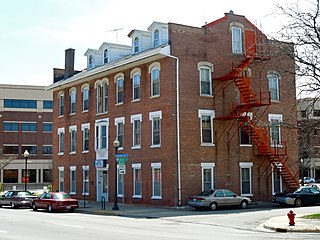
The Galena Hotel, originally known as the Fox River House, is a historic hotel in Aurora, Illinois. It is the oldest hotel still standing in the city.
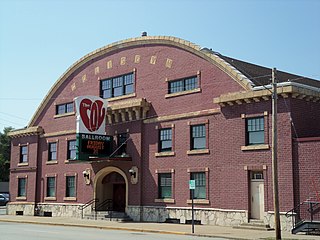
The Col Ballroom is a historic building located in the West End of Davenport, Iowa, United States. It was listed on the National Register of Historic Places and on the Davenport Register of Historic Properties as the Saengerfest Halle.
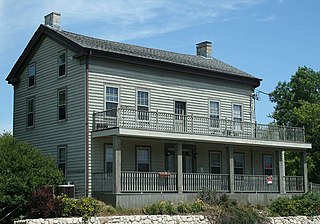
The Payne Hotel is a former stagecoach inn located along Highway 33 in Saukville, Wisconsin. Deemed worthy of preservation, the hotel has been listed on the National Register of Historic Places since March 14, 1991.

The Midwest Athletic Club is a historic athletic club building located at 6 N. Hamlin Ave. in the West Garfield Park community area of Chicago, Illinois. The club was built in 1926-28 under the direction of a committee of West Side business leaders. The thirteen-story building's design featured ornamental terra cotta, large arched windows on the third floor, and a mansard roof; it also provided views of Garfield Park, the north side of which was across the street. Its facilities included an Olympic-sized swimming pool, a gymnasium and exercise rooms, handball courts, billiard rooms, a library, dining rooms, and a ballroom. The club grew to include 2000 members in its first year, most of them businessmen and their families; however, the building entered receivership in 1930 and was converted into a hotel.

The Chicago & North Western Railway Stone Arch Bridge, also known as the Kinnikinnick Creek Railway Bridge, is a historic Chicago and North Western Railway bridge that crosses South Kinnikinnick Creek east of Roscoe, Illinois. The bridge was built in 1882 to replace a wooden bridge; the line it was on opened in 1853 as part of the Galena and Chicago Union Railroad and originally connected Belvidere, Illinois and Beloit, Wisconsin. C&NW Chief Engineer Van Mienen designed the double arch dolomitic limestone bridge, which is 53 feet (16 m) long, 60 feet (18 m) wide, and 58 feet (18 m) high. The railroad allowed the sand quarrying industry in Roscoe and South Beloit to ship its products to construction sites in Chicago; the bridge is one of the few surviving remnants of the railroad in Roscoe. The bridge is the only stone-faced rubble fill bridge with more than one arch in Winnebago County; the nearest bridge of the type is a five-arch bridge in Tiffany, Wisconsin.







